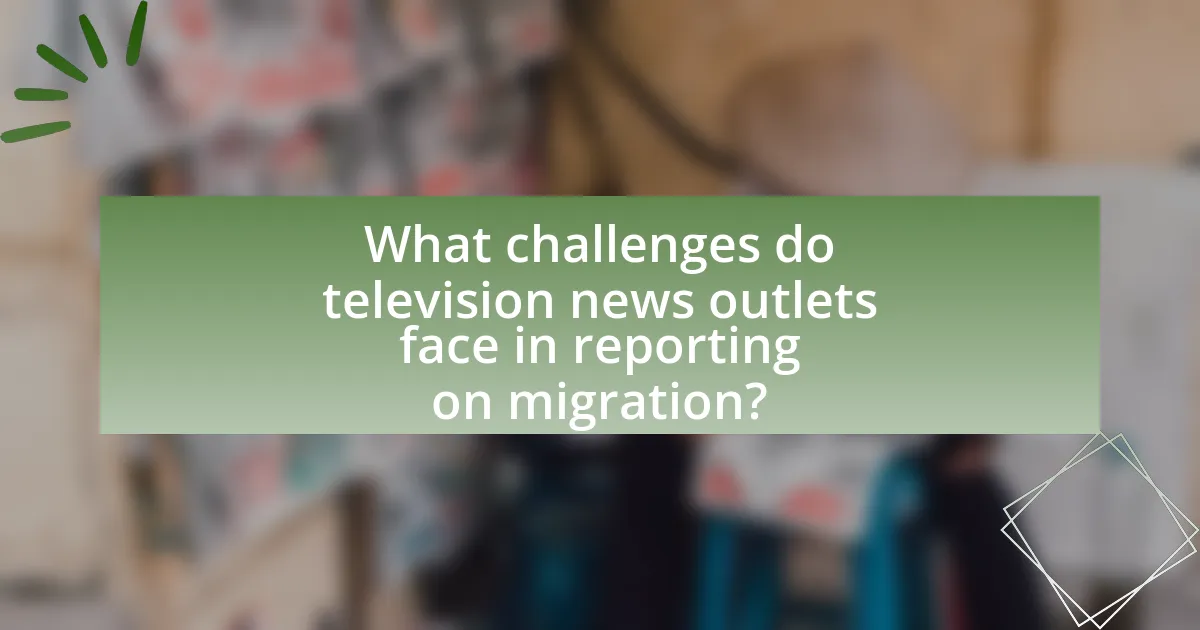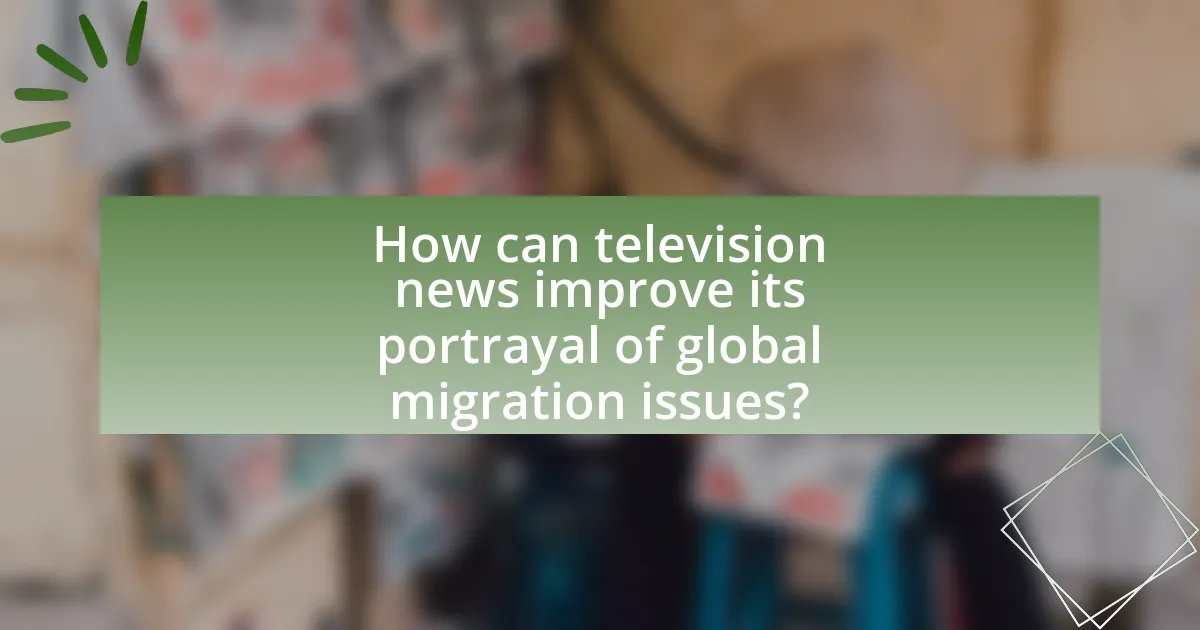The article examines how television news portrays global migration issues, highlighting the emphasis on crisis, conflict, and humanitarian concerns. It identifies key themes in migration coverage, such as humanitarian crises, border security, economic impact, and cultural integration, while discussing how different news outlets frame these stories based on their political affiliations. The article also explores the narratives commonly used in migration reporting, the ethical considerations involved, and the impact of media representation on public perception and policy discussions. Additionally, it addresses the challenges faced by news outlets in accurately reporting migration issues and suggests best practices for improving coverage, emphasizing the importance of diversity in newsrooms and audience engagement.

How does television news portray global migration issues?
Television news often portrays global migration issues through a lens that emphasizes crisis, conflict, and humanitarian concerns. This portrayal frequently highlights the struggles faced by migrants, such as dangerous journeys, overcrowded refugee camps, and the impact of political policies on their lives. For instance, reports on the Mediterranean migration crisis have shown images of perilous sea crossings and the tragic loss of life, underscoring the urgency of the situation. Additionally, statistics from organizations like the United Nations High Commissioner for Refugees indicate that there were over 26 million refugees worldwide in 2021, which television news often uses to illustrate the scale of the migration crisis. This focus on dramatic narratives can shape public perception, leading to increased awareness but also potential stigmatization of migrants.
What are the key themes in television news coverage of migration?
Key themes in television news coverage of migration include humanitarian crises, border security, economic impact, and cultural integration. Humanitarian crises are often highlighted through reports on refugee camps and the struggles faced by migrants, emphasizing the urgent need for assistance. Border security is frequently discussed, focusing on policies and enforcement measures that affect migration flows, often portraying migrants in a contentious light. Economic impact themes explore how migration influences labor markets and economies, with narratives that can either support or oppose migration based on perceived benefits or burdens. Cultural integration themes address the challenges and successes of migrants assimilating into host societies, showcasing personal stories that humanize the migration experience. These themes reflect broader societal attitudes and political debates surrounding migration, shaping public perception and policy discussions.
How do different news outlets frame migration stories?
Different news outlets frame migration stories through various lenses, often influenced by their political affiliations and target audiences. For instance, conservative outlets may emphasize security concerns and portray migrants as threats, while liberal outlets often highlight humanitarian aspects and the struggles faced by migrants. A study by the Pew Research Center found that 62% of stories from conservative sources focused on crime related to migration, whereas 70% of stories from liberal sources emphasized the human rights of migrants. This framing shapes public perception and policy discussions surrounding migration issues.
What narratives are commonly used in migration reporting?
Common narratives used in migration reporting include the “crisis narrative,” which emphasizes the urgency and danger associated with migration, often portraying migrants as victims or threats. Another prevalent narrative is the “economic opportunity narrative,” highlighting the contributions of migrants to host countries’ economies, such as filling labor shortages and driving innovation. Additionally, the “human interest narrative” focuses on individual stories of migrants, showcasing their struggles and aspirations to evoke empathy from the audience. These narratives shape public perception and policy discussions surrounding migration, as evidenced by studies indicating that media framing significantly influences audience attitudes towards migrants and migration policies.
Why is the portrayal of migration important in television news?
The portrayal of migration is important in television news because it shapes public perception and influences policy decisions. Accurate representation of migration issues can foster understanding and empathy towards migrants, while sensationalized or biased coverage can lead to stigma and misinformation. For instance, a study by the Pew Research Center found that negative portrayals of migrants in media correlate with increased public support for restrictive immigration policies. Thus, the way migration is depicted in television news plays a crucial role in informing societal attitudes and legislative actions regarding migration.
How does media representation influence public perception of migrants?
Media representation significantly influences public perception of migrants by shaping narratives and framing issues surrounding migration. For instance, studies show that negative portrayals in news media often lead to increased public fear and hostility towards migrants, while positive representations can foster empathy and understanding. Research conducted by the Pew Research Center indicates that 62% of Americans believe that media coverage of immigrants is mostly negative, which correlates with rising anti-immigrant sentiments. Furthermore, the framing of migrants as either victims or threats can dictate public attitudes and policy responses, as evidenced by the portrayal of refugees in crisis situations versus economic migrants. This demonstrates that the way media presents migrants directly impacts societal views and can either exacerbate or alleviate tensions surrounding migration issues.
What role does television news play in shaping migration policy discussions?
Television news plays a significant role in shaping migration policy discussions by influencing public perception and political agendas. Through the framing of migration stories, television news can highlight specific narratives, such as humanitarian crises or economic impacts, which in turn affect how policymakers approach migration issues. For instance, studies have shown that increased coverage of migrant tragedies can lead to heightened public empathy and pressure on governments to adopt more humane policies. Additionally, the portrayal of migrants in television news can reinforce stereotypes or challenge them, ultimately impacting legislative priorities and public opinion on migration reform.

What challenges do television news outlets face in reporting on migration?
Television news outlets face significant challenges in reporting on migration, primarily due to the complexity of the issue, the need for accurate representation, and the potential for sensationalism. The multifaceted nature of migration involves legal, social, and economic dimensions, making it difficult for news outlets to provide comprehensive coverage. Additionally, the portrayal of migrants can often be skewed, leading to stereotypes and misinformation, which can exacerbate public fear and misunderstanding. For instance, a study by the Pew Research Center found that media framing can influence public perception, highlighting the responsibility of news outlets to report ethically and accurately. Furthermore, logistical challenges such as accessing migration hotspots and ensuring the safety of reporters can hinder effective reporting.
How do biases affect migration coverage in television news?
Biases significantly affect migration coverage in television news by shaping narratives that can either demonize or humanize migrants. For instance, studies have shown that news outlets often emphasize negative aspects of migration, such as crime or economic burden, which can lead to public fear and xenophobia. A 2018 report by the Pew Research Center found that 62% of Americans believed that immigrants increase crime, a perception largely influenced by sensationalized media portrayals. Conversely, some outlets may adopt a more sympathetic approach, focusing on personal stories of struggle and resilience, which can foster empathy and support for migrants. This duality in coverage reflects underlying biases that can skew public perception and policy discussions regarding migration.
What are the sources of bias in migration reporting?
Sources of bias in migration reporting include selective framing, sensationalism, and reliance on stereotypes. Selective framing occurs when media outlets emphasize certain aspects of migration, such as crime or economic burden, while downplaying positive contributions migrants make to society. Sensationalism often leads to exaggerated portrayals of migrants, creating fear and misunderstanding among the public. Additionally, reliance on stereotypes can perpetuate negative images of migrants, influencing public perception and policy. Research by the Pew Research Center indicates that media coverage often focuses on negative narratives, which can skew public opinion and reinforce biases against migrant populations.
How can biases impact the accuracy of migration stories?
Biases can significantly distort the accuracy of migration stories by shaping the narrative and influencing public perception. For instance, media outlets may emphasize negative aspects of migration, such as crime or economic burden, while downplaying positive contributions, like cultural enrichment or economic growth. A study by the Pew Research Center found that news coverage often highlights sensational stories, which can lead to a skewed understanding of migration issues. This selective reporting can perpetuate stereotypes and misinformation, ultimately affecting policy decisions and societal attitudes towards migrants.
What ethical considerations are involved in reporting migration issues?
Reporting migration issues involves several ethical considerations, primarily the responsibility to portray migrants accurately and sensitively. Journalists must avoid perpetuating stereotypes and biases that can dehumanize individuals seeking refuge or better opportunities. For instance, framing migrants solely as a burden can lead to public fear and hostility, while emphasizing their contributions can foster understanding and empathy.
Additionally, respecting the privacy and dignity of migrants is crucial; revealing personal details without consent can endanger their safety and well-being. Ethical reporting also requires balancing the public’s right to know with the potential harm that sensationalized stories can cause to vulnerable populations. The Society of Professional Journalists emphasizes the importance of minimizing harm in reporting, which is particularly relevant in the context of migration, where individuals may already be facing significant challenges.
How do journalists balance sensationalism and factual reporting?
Journalists balance sensationalism and factual reporting by adhering to ethical standards and prioritizing accuracy over dramatic storytelling. They often implement fact-checking processes, consult multiple sources, and rely on data to ensure that their reports are grounded in reality. For instance, the Society of Professional Journalists emphasizes the importance of seeking truth and reporting it, which helps mitigate sensationalism. Additionally, many news organizations have editorial guidelines that discourage exaggeration and promote responsible reporting, ensuring that the portrayal of sensitive topics, such as global migration issues, remains factual and respectful.
What responsibilities do news outlets have towards migrant communities?
News outlets have the responsibility to provide accurate, fair, and respectful coverage of migrant communities. This includes avoiding sensationalism and stereotypes that can perpetuate stigma and discrimination. For instance, research by the Pew Research Center indicates that negative portrayals can influence public perception and policy regarding immigration. Furthermore, news outlets should strive to include diverse voices from migrant communities, ensuring their stories and experiences are represented. This approach not only fosters understanding but also promotes informed discourse on migration issues.

How can television news improve its portrayal of global migration issues?
Television news can improve its portrayal of global migration issues by providing more comprehensive and nuanced coverage that includes the voices and experiences of migrants themselves. This approach can be supported by research indicating that narratives featuring personal stories foster empathy and understanding among viewers, as demonstrated in studies by the Pew Research Center, which found that personal accounts can significantly influence public perception of migration. Additionally, incorporating expert analysis and data on the socio-economic impacts of migration can help contextualize the challenges and contributions of migrants, moving beyond sensationalist headlines. By focusing on these elements, television news can create a more informed and balanced discourse surrounding global migration issues.
What best practices should news outlets adopt for migration reporting?
News outlets should adopt accuracy, sensitivity, and context as best practices for migration reporting. Accuracy ensures that information about migrants and their situations is factually correct, which is crucial given the often complex and nuanced nature of migration issues. Sensitivity involves understanding the emotional and social implications of migration, avoiding dehumanizing language, and respecting the dignity of individuals involved. Context is essential to provide a comprehensive understanding of migration patterns, including historical, political, and economic factors that influence migration. For instance, the International Organization for Migration emphasizes the importance of contextual reporting to avoid perpetuating stereotypes and misinformation. By adhering to these best practices, news outlets can contribute to informed public discourse on migration issues.
How can diversity in newsrooms enhance migration coverage?
Diversity in newsrooms enhances migration coverage by providing a broader range of perspectives and experiences that reflect the complexities of migration issues. When newsrooms include individuals from various cultural, ethnic, and socioeconomic backgrounds, they are more likely to understand and accurately represent the narratives of diverse migrant populations. Research indicates that diverse teams produce more comprehensive and nuanced reporting, which can lead to increased public awareness and empathy regarding migration challenges. For instance, a study by the American Society of News Editors found that diverse newsrooms are better at covering stories that resonate with underrepresented communities, ultimately leading to more informed audiences.
What role does audience engagement play in improving migration narratives?
Audience engagement plays a crucial role in improving migration narratives by fostering a deeper understanding and empathy towards migrants’ experiences. Engaged audiences are more likely to challenge stereotypes and misinformation, leading to more nuanced and accurate portrayals of migration in media. Research indicates that when audiences actively participate in discussions or share their perspectives, it enhances the representation of diverse migrant stories, thereby enriching the overall narrative. For instance, studies show that interactive platforms, such as social media, allow for real-time feedback and dialogue, which can shift public perceptions and encourage more responsible reporting by news outlets.
What resources are available for journalists covering migration issues?
Journalists covering migration issues have access to various resources, including specialized organizations, databases, and training programs. Organizations such as the International Organization for Migration (IOM) and the United Nations High Commissioner for Refugees (UNHCR) provide comprehensive reports, statistics, and guidelines on migration trends and policies. Additionally, databases like the Global Migration Data Portal offer valuable data sets that can enhance reporting accuracy. Training programs and workshops, often conducted by journalism schools or NGOs, equip journalists with the skills needed to report sensitively and accurately on migration topics. These resources collectively support informed and responsible journalism in the context of migration.
How can training programs help journalists report on migration more effectively?
Training programs can help journalists report on migration more effectively by equipping them with specialized knowledge and skills necessary for accurate and sensitive reporting. These programs often cover critical aspects such as understanding migration policies, cultural sensitivity, and ethical considerations, which are essential for portraying the complexities of migration issues. For instance, training can include workshops on interviewing migrants respectfully and understanding the socio-political contexts that drive migration, thereby reducing the risk of perpetuating stereotypes or misinformation. Research indicates that journalists who undergo such training are more likely to produce nuanced stories that reflect the realities of migrants’ experiences, leading to better public understanding of migration issues.
What organizations provide support and information for migration reporting?
Organizations that provide support and information for migration reporting include the International Organization for Migration (IOM), the United Nations High Commissioner for Refugees (UNHCR), and the Migration Policy Institute (MPI). The IOM offers data and resources on migration trends and policies, while the UNHCR focuses on the protection of refugees and displaced persons, providing critical information for accurate reporting. The MPI conducts research and analysis on migration issues, contributing valuable insights that inform media coverage. These organizations are recognized for their expertise and reliability in the field of migration, making them essential resources for journalists and researchers.
What are the implications of improved migration reporting for society?
Improved migration reporting has significant implications for society, primarily by fostering informed public discourse and shaping policy decisions. Accurate and comprehensive migration data can counteract misinformation and stereotypes, leading to a more nuanced understanding of migration issues. For instance, studies have shown that communities exposed to factual reporting on migration are less likely to harbor xenophobic attitudes. Furthermore, enhanced reporting can influence policymakers to adopt evidence-based approaches, as seen in countries where data-driven narratives have led to more humane immigration policies. This shift not only benefits migrants but also promotes social cohesion and economic integration within host societies.
How can accurate migration coverage foster empathy and understanding?
Accurate migration coverage can foster empathy and understanding by presenting the human stories behind migration statistics, thereby humanizing migrants and highlighting their struggles and aspirations. When media outlets provide detailed narratives about individual migrants, including their backgrounds, reasons for migration, and experiences, audiences can relate to them on a personal level. Research indicates that stories that evoke emotional responses can significantly increase empathy; for instance, a study published in the journal “Communication Research” found that narratives about marginalized groups can lead to greater understanding and support among viewers. By focusing on the complexities of migration rather than reducing it to mere numbers or stereotypes, accurate coverage encourages audiences to see migrants as individuals with unique stories, ultimately promoting a more compassionate perspective.
What impact does responsible reporting have on migration policies and practices?
Responsible reporting significantly influences migration policies and practices by shaping public perception and informing policymakers. Accurate and balanced media coverage can lead to increased awareness of migration issues, fostering empathy and understanding among the public, which in turn pressures governments to adopt more humane policies. For instance, studies have shown that media portrayals of migrants can affect public attitudes; when migrants are depicted positively, there is often a corresponding increase in support for inclusive policies. Conversely, sensationalist reporting can incite fear and lead to stricter immigration controls. Therefore, responsible reporting serves as a critical tool in guiding the discourse around migration, ultimately impacting legislative outcomes and societal attitudes.




